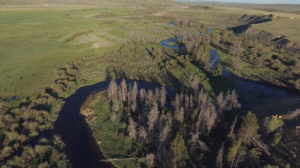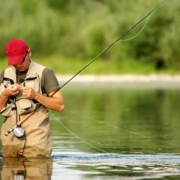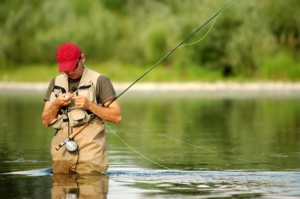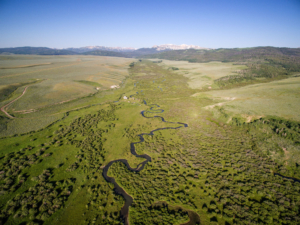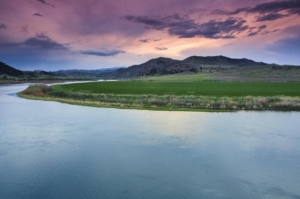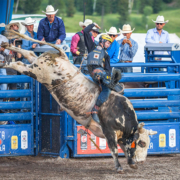With more than 27,000 miles of fishable waters, Wyoming is an angler’s dream come true. From glacial lakes to big tailwaters that support thousands of trout per mile, it’s little wonder one of the country’s most expansive states is also one of the world’s most popular fishing destinations.
Below is a guide to Wyoming’s best trout fishing rivers from our friends at Orvis. Contact our team to learn more about why the Cowboy State is one of the last best kept secrets in fishing and to explore how to experience this remarkable region.
YELLOWSTONE RIVER (PARK SECTION)
Fly fishing the Upper Yellowstone River within Yellowstone National Park takes anglers to one of the remotest regions of the lower 48 states, and the headwaters of the longest free-flowing river in the US. The first 25 miles of the Yellowstone River flow through the Park, and Yellowstone cutthroat thrive in its freestone waters. While the cascading headwaters hold mostly smaller cutthroats, the winding, slower water between Thorofare and Yellowstone Lake hold many fish reaching the 20-inch mark, or above.
FIREHOLE RIVER & SLOUGH CREEK
Yes, they’re all amazing, and it’s hard to pick just one river in or around Yellowstone National Park, while leaving room to discuss other regions of Wyoming. It would take a lifetime to discover what each of these pristine rivers has to offer — or you could hire a Yellowstone National Park guide who already has the experience. The Firehole River and Slough Creek both provide quintessentially Western fly-fishing experiences and no list of the best fly-fishing rivers in Wyoming would be complete without them. Whether you’re casting next to geysers and geothermal features along the Firehole, or sight fishing cutthroat along Slough Creek’s meadows, Yellowstone National Park’s rivers will make you think you’ve gone to angler’s heaven.
SNAKE RIVER
South of Yellowstone National Park you’ll find Grand Teton National Park and the Snake River. If you’ve never heard of fly fishing before, you’ll likely have seen a picture of the Wyoming section of the Snake River. Its scenic path through the valley of Jackson Hole is a photographer’s dream. But the cutthroats and browns (lower sections of the park) are what draw anglers from all over the world. The river begins as a series of small creeks, 15 miles from the nearest road. Most fish here are cutthroats in the eight- to ten-inch range, but for a true wilderness fishing experience, few places in the Lower 48 can compare. Below Jackson Lake, the Snake River grows to an easily floatable river with gravel bars, riffles, and pools. While you can wade fish sections with great success, only a float trip will do the Snake River Canyon justice. Talk to a Jackson, Wyoming guide or outfitter, and they’ll help you discover this gem of the American West.
GREEN RIVER
Better known on the Utah side of the border, the Green River in Wyoming provides outstanding fly-fishing opportunities for browns, ‘bows, and cutthroats on its journey from the Wind River Range to the Flaming Gorge Reservoir. Forming on the western side of the Winds, the Green begins with over a hundred miles of freestone river with much of its banks accessible through public land. The cutthroat and ‘bows in this section are typically smaller, but a strong 16-inch trout sipping dries from the fast flowing riffles is quite common. Just downstream of La Barge, the Green enters Fontenelle Reservoir. The next 40 miles below the reservoir provide trophy trout fishing on a classic tailwater, with ample access points through Seedskadee National Wildlife Refuge. If you’re looking for a classic Western fly-fishing destination where you may not see another angler all weekend, the Wyoming section of the Green should be at the top of your list.
WIND RIVER & EAST FORK OF THE WIND RIVER
The Wind River begins its journey atop Togwotee Pass in the Absaroka Mountains, and picks up water from the eastern side of the Wind River Range as it heads south. Its glaciated namesake range holds some of the best high-country lake fishing in the Lower 48. But often overlooked is the river flowing to the east of the peaks. For its first 30 miles, the Wind River’s brook trout and cutthroat freestone waters can be fished with a general Wyoming fishing license. Then the river enters the Wind River Indian Reservation, which offers its own fishing permit. Here, the river grows and supports plentiful populations of cutthroat, rainbow, and brown trout. The Wind River enters Boysen Reservoir near Shoshoni, WY, and upon exit, flows through Wind River Canyon — a productive tailwater with many trout reaching the 20-inch mark, and above. The Wind River is truly one of central Wyoming’s premier fly-fishing destinations.
BIGHORN RIVER
As the Wind River exits the canyon and nears the town of Thermopolis, it becomes the Bighorn River. Better known for its tailwater fishery across the border in Montana, Wyoming’s section of the Bighorn should not be overlooked. The Thermopolis section enjoys the same tailwater benefits as the Wind River Canyon section, upstream. With a slower descent and median summer flows ranging from 1300 to 1600 CFS, this section of the Bighorn is most effectively fished on a float trip. From Thermopolis to Lucerne, anglers regularly hook into browns measuring 20 inches or more — all thanks to the consistent temperature and flow from Boysen Reservoir. Spring and summer bring BWOs and caddis, but the trico hatches from June to early October excite most dry fly anglers. Think there’s only one Bighorn worth fishing? Think again.
NORTH PLATTE RIVER, GRAY REEF & MIRACLE MILE
Wyoming’s North Platte River Gray Reef holds nearly 5,200 trout per mile. If every trout was 12 inches long, you could essentially line them up into one solid ribbon of trout stretching the entire Gray Reef section. But we all know trout follow the food, so take some time to study the water before wading or drifting — or, hire a local Wyoming fly-fishing guide to show you where the big fish are holding. From Casper, head southeast a half hour to Alcova. The Gray Reef begins below Alcova Reservoir and runs north along WY-220. Access is limited, with much of the surrounding land under private ownership. To get a true taste of Gray Reef and its eight-pound (plus) browns and ‘bows, talk to a North Platte river guide or outfitter about reserving a float trip.
About 20 miles upstream, between Pathfinder Reservoir and Kortes Dam, you’ll find the Miracle Mile stretch of the North Platte. Contrary to its name, the Miracle stretches between five and eight miles, depending on the water levels of the Pathfinder Reservoir. The tailwater conditions below Kortes Dam provide plentiful food, allowing for hundreds, if not thousands, of trout to grow to trophy size. Load up your nymph box, and your gas tank, as the Miracle Mile is about 20 miles from the nearest paved road.
UPPER NORTH PLATTE RIVER
The upper reaches of the North Platte River provide a freestone fishing experience much different, but no less exciting, than the trophy waters below. While water levels are less reliable than the dam-controlled water downstream, the North Platte near Saratoga and Medicine Bow National Forest is easily floatable through much of the season and can be floated spring through fall in big snowpack years. A float trip isn’t necessary, however, as this section of water has numerous access points, including a long section through the National Forest. From its headwaters all the way to the town of Saratoga, the North Platte is designated Blue Ribbon trout fishing with at least 600 pounds of trout per mile. So, whether the BWO’s, yellow sallies, or PMD’s are hatching, or you’re looking for trout subsurface, the Upper North Platte is a Wyoming fly-fishing experience not to be missed.
TONGUE RIVER
The Bighorn Mountains, in the north central block of Wyoming, are one of the lesser known ranges in the West. From the range’s eastern slopes, the Tongue River drains northeast, through Dayton, Ranchester, and Kleenburn, towards Montana, before it joins up with the Yellowstone River. At 265 miles long, only the upper reaches, within Wyoming, are prime trout fishing waters. From Sheridan, it’s a half-hour drive to Dayton, where there are multiple access points to the main river. This section consists of riffles and runs, flowing over gravel into deep pools, which hold big browns, ‘bows, and cutthroat. Upstream in Bighorn National Forest, the Tongue is divided into the North and South Tongue Rivers. Both provide diverse fishing experiences, with sections of gentle, meadow-lined banks and faster pocket water. To find a slice of solitude, venture into the canyon section of the North Tongue River, which is accessible only by hiking into the bottom of the canyon.
SAND CREEK
Most anglers visiting Wyoming to fly fish head to the central or western thirds of the state, for good reason. But hugging the border of South Dakota, Wyoming’s Black Hills give birth to the limestone-lined Sand Creek. This is not a mighty river like the North Platte or Snake: it’s a slow, meandering creek, fed by springs and lined by grassy banks. But thanks to the cold spring water and nutrients, Sand Creek is home to one of the highest concentrations of trout in all of Wyoming. While there may be literally tons of fish, the gin-clear, slow water gives them an easy view of approaching anglers, and poorly presented flies. You’ll need to bring your best presentation and stealth to Sand Creek, but the payoff and alternative scenery are well worth the adventure.
Contact our team to learn more about Wyoming fishing and fishing properties that put this lifestyle at your fingertips.
*Article courtesy of Western Ranches, a division of Jackson Hole Real Estate Associates.


